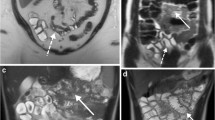Abstract
To evaluate usefulness of pirenzepine, a selective M1 antimuscarinic drug, for diagnostic doublecontrast study of the upper gastrointestinal tract, pirenzepine and scopolamine methylbromide (SMB) were compared in a single blind randomized trial. Seventy consecutive patients were enrolled in the study. Artifacts, bowel distention, painting of stomach and duodenal bulb, and global quality of the images were blindly evaluated by four independent observers by means of a numerical score (1–4). Under SMB slightly but significantly better results for stomach were scored (3.1±.7 vs. 2.7±7, p< 0.01). No differences were found in the study of the duodenal bulb. Heart rate and rhythm during the study were recorded by electrocardiogram (ECG). SMB induced tachycardia in all patients (from 77±20 to 117±28 beats/min, p < 0.01) while pirenzepine did not (from 77±16 to 81±23, p = NS). After SMB, two patients exhibited faintness, and some patients complained of visual accommodation defects, dryness of the mouth, and dizziness. Thus, pirenzepine provides good results in double-contrast studies (equal to SMB), while presenting no adverse effects. It could be proposed as a first choice hypotonic agent in upper gastrointestinal examination.
Similar content being viewed by others
References
Shirakabe H. Double contrast studies of the stomach. Stuttgard: G Thieme, 1972.
Carmine AA, Brogden RN. Pirenzepine: a review of its pharmacodynamic and pharmacokinetic properties and therapeutic efficacy in peptic ulcer diseases and other allied diseases. Drugs 1985;30:85–91.
Goyal RK. Muscarinic receptor subtypes: physiology and clinical implications. N Engl J Med 1989;321:1022–1029.
Soffer EE, Kumar D, Mridha K, Das-Gupta A, Britto J, Wingate DL. Effect of pirenzepine on oesophageal, gastric and enteric motor function in man. Scand J Gastroenterol 1988;23:146–150.
Di Somma C, Arnulfo C, Mortola G, Dato D, Serafini P, Rezzo R, Imbimbo BP, Reboa G. Effects of pirenzepine and atropine on gastroduodenal motor patterns in duodenal ulcer patients. Scand J Gastroenterol 1986;21:1046–1050.
Armbrecht U, Reul W, Stockbrugger RW. The influence of telenzepine on gastrointestinal transit: comparison with placebo and domperidone. Z Gastroenterol 1990;28:85–89.
Tomas-Ridocci M, Mora F, Molina R, Moreno-Osset E, Mingez M, Benages A. Effect of pirenzepine and atropine on the motile function of the esophagus. Comparative study. Rev Esp Enferm Apar Dig 1987;72:299–302.
Geller LI, Petrenko VG, Geller AL. Clinical pharmacology of agents affecting the tonus of the lower esophageal sphincter. Ter Arkh 1986;58:111–114.
Llamas-Elvira JM, Sopena R, Martinez-Paredes M, Jimenez-Heffernan A, Gonzalez FM, Torres M, Latre JM, Mateo A. Muscarinic control of gallbladder dynamics: a study using 99Tcm-HIDA and cholinergic agonists and antagonists. Nucl Med Commun 1990;11:813–817.
Garrigues V, Ponce J, Pertejo V, Sala T, Berenguer J. Effects of atropine and pirenzepine on sphincter of Oddi motility: a manometric study. J Hepatol 1986;3:247–250.
Jaup BH. Effect of pirenzepine on sigmoid motility [letter]. Dtsch Med Wochenschr 1987;112:1150.
Imhof M, Schmidt E, Bruch HP, Plesch B, Henrich H. Effect of pirenzepine on sigmoid motility [letter]. Dtsch Med Wochenschr 1987;112:366–367.
Wellstein A, Pitschner HF. Complex dose-response curves of atropine in man explained by different functions of M1 and M2 cholinoreceptors. Naunyn-Schmiedeberg's Arch Pharmacol 1988;338:19–27.
Marraccini P, Orsini E, Nassi G, Michelassi C, L'Abbate A, Usefulness of pirenzepine, an M1 antimuscarinic agent, for effort myocardial ischemia. Am J Cardiol 1992;69:1407–1411.
Roussel J, Regent D, Bigard MA. Radiologie digestive en double contrast. Paris: Masson, 1976
Author information
Authors and Affiliations
Rights and permissions
About this article
Cite this article
Braccini, G., Marraccini, P., Marrucci, A. et al. Usefulness and safety of pirenzepine in double-contrast study of upper gastrointestinal tract: Comparison with scopolamine methylbromide. Abdom Imaging 19, 201–206 (1994). https://doi.org/10.1007/BF00203506
Received:
Accepted:
Issue Date:
DOI: https://doi.org/10.1007/BF00203506




